Packing List
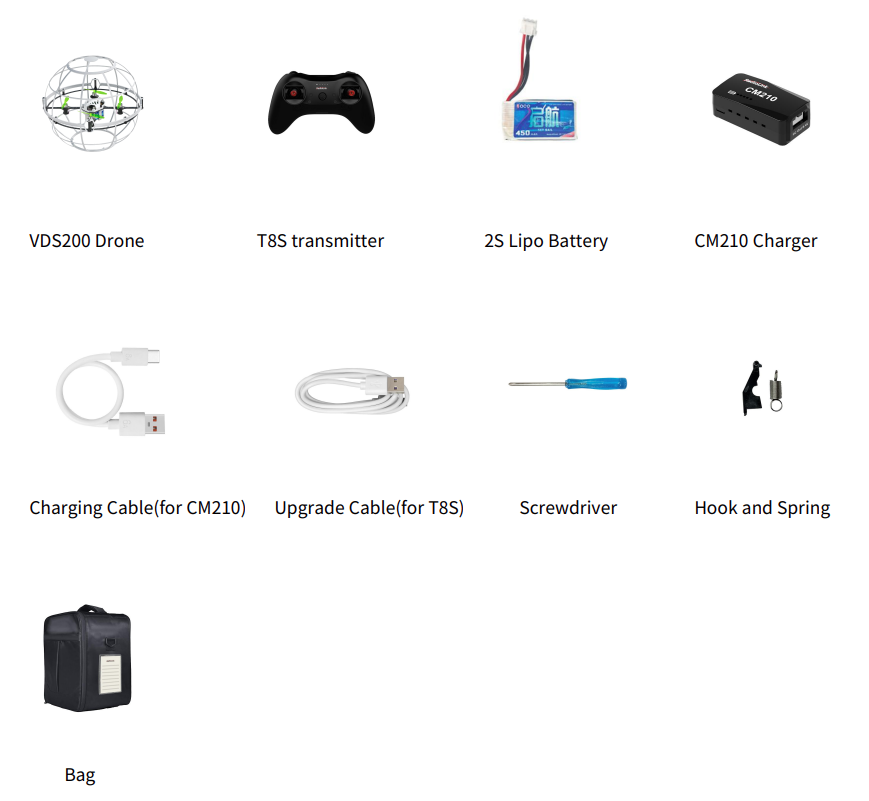
Chapter 1 VDS200 Introduction
1.1 Features of VDS200
VDS200 is a coreless soccer drone. The inertial navigation of the gyro, accelerometer, and barometer and the Kalman filter altitude-hold algorithm perfectly solves the contradiction between high speed and stability, greatly reducing the difficulty of beginning and allowing the public to experience the stable flying pleasure. It supports Alt-hold (low speed) mode, Alt-hold (high speed) mode and stabilize mode.
The RTF version comes with an 8-channel remote controller which can be adjusted parameters by mobile phone APP.
The motor adopts unique software noise reduction technology, which not only makes VDS200 noise-free during flight, but also greatly extends the service life of the motor.
VDS200 breaks through the defects of traditional Euler angles and adopts the rotation vector algorithm to achieve high-speed climbing and descending flight in Alt-hold mode, so pilots can enjoy the fun of the drone competition in the air.
1.2 Specifications
|
Name |
VDS200 |
|
Weight |
120g |
|
Dimension |
200mm*200mm(±10mm) |
|
Material |
Carbon Fiber (Frame), Plastic (Ball shells, cover, battery case) |
|
Transmitter |
RadioLink T8S |
|
Motor |
SZ-SPEED Coreless Motors |
|
Propeller |
Gemfan Propellers |
|
Output Frequency |
2.4G |
|
Receiver |
R8SM receiver, with SBUS and PPM signal output |
|
Flight Controller |
RadioLink 210 FT Flight Controller, SBUS supported |
|
Battery |
Gensace 2S Lipo Battery |
|
Charger |
RadioLink CM210 |
|
Flight Modes |
Alt-hold(low speed) mode, Alt-hold(high speed) mode, and Stabilize mode |
|
Flight Time |
6 Minutes |
|
Flight Environment |
Indoors/Outdoors |
|
Low Voltage Alarm |
When the voltage is below 7.2V, the green LED of FC will flash |
|
Package |
Portable Bag |
Chapter 2 Before Flight
2.1 Power Supply
Power for transmitter T8S: Make sure the transmitter is fully charged.
Power for VDS200: The voltage of 2S LiPo battery packed with VDS200 is not fully charged by default, so the battery needs to be charged with the charger CM210 before flight.
The LiPo battery charger CM210, specially designed for 2S LiPo battery, sharing the professional development and high precision of CB86PLUS, ensures safer charging and battery life span.
CM210 Instruction for Use:
Insert one end of the standard USB cable into the Type-C input port of the CM210 charger (as shown in the picture below), and then connect the other end of the USB cable to power supply equipment such as power bank, computer, mobile phone adapter, etc.(Input Voltage: 5V) After the right connection, the red LED indicator will be always on.
Insert the balance port of the standard 2S lithium battery of A560 into the charging port of CM210 (as shown in the picture below). Then the green LED indicator starts flashing, which means it starts to charge the battery. (Note: The green LED indicator flashes during the charging to indicate normal charging; If the red LED indicator flashes during the charging to indicate abnormal charging. Please reconnect battery and cable to troubleshoot the abnormality.)
When all four LED indicators turn solid green, the battery is fully charged, and the charger will automatically stop charging.
Remove the battery and then disconnect the power supply.
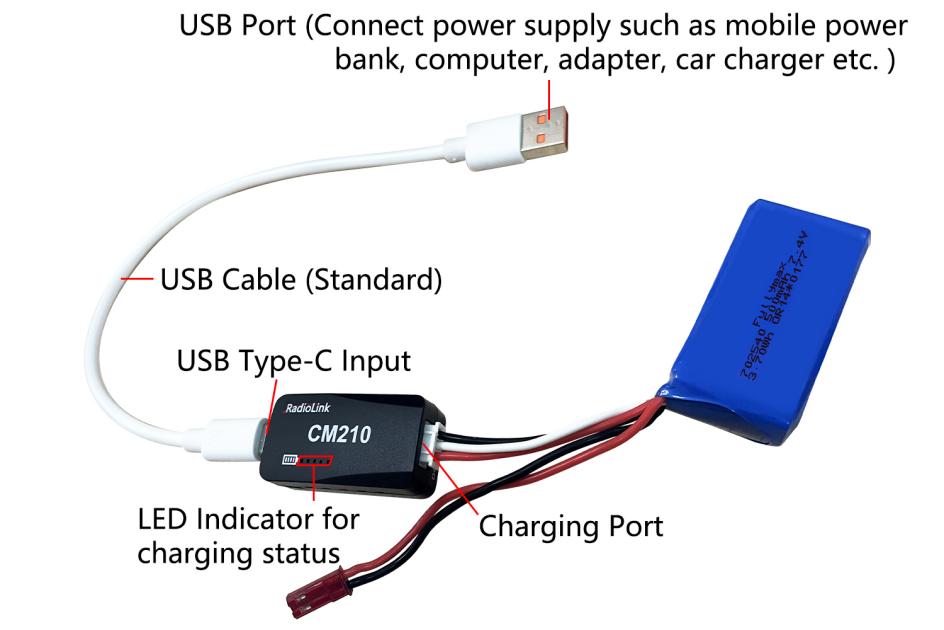
CM210 LED Indicator Status:
|
LED color |
Status |
Meaning |
|
Red |
Flash |
The charger detects abnormality. |
|
|
Always on |
No battery is connected. |
|
Green |
All four green LEDs flash once. |
The charger is powered on. |
|
The first green LED flashes, and the other LEDs are off. |
The battery voltage is lower than 7.4V. | |
|
The first green LED is always on, and the second green LED is flashing. The other LEDs are off. |
The battery voltage is lower than 7.8V. |
|
|
The front two green LEDs are always on, and the third green LED is flashing. The other LEDs are off. |
The battery voltage is lower than 8.2V. |
|
|
The front three green LEDs are always on, and the fourth green LED is flashing. The other LED is off. |
The battery voltage is lower than 8.4V. |
|
All four green LEDs are always on. |
The battery is fully charged. |
2.2 VDS200 Direction Indication
There is a power cable at the tail of the aircraft. When it is powered on, the flight control indicator at the tail will light up (see below for color explanation), making it easy to distinguish the direction of the aircraft.
2.3 Joysticks & Flight Movements
A. Throttle: Rise/ Descend/Hover
Toggle the throttle stick (on the left) vertically upward and VDS200 will rise and toggle the throttle vertically downward, then VDS200 descends.
If at Alt-Hold Mode, toggle the throttle stick vertically upward till the VDS200 rises to the preferred height, then toggle back to center position and release, the VDS200 will remain at this height.
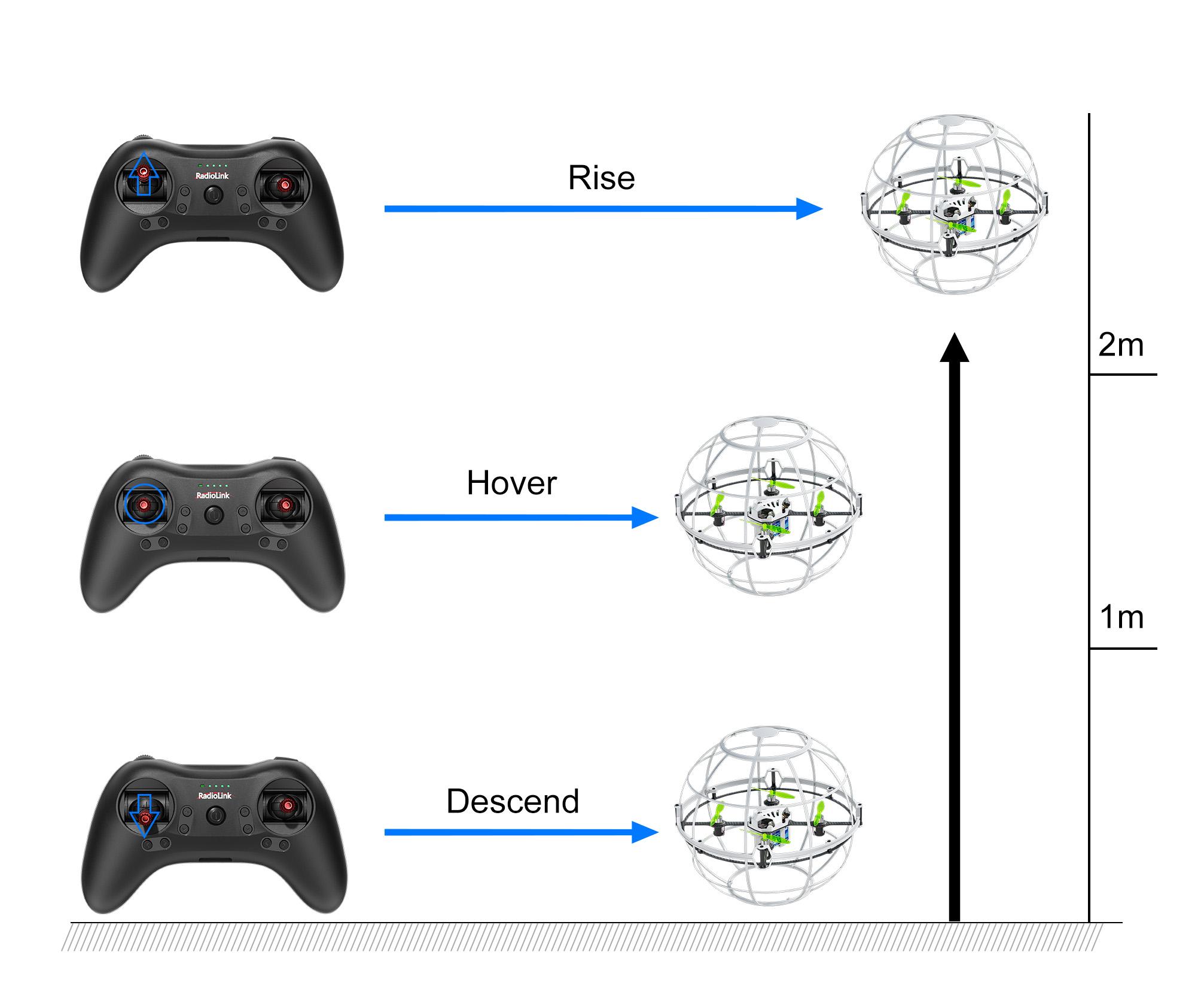
Yaw: Clockwise/Anticlockwise
Toggle the yaw stick (on the left) to the left and VDS200 will turn anticlockwise and toggle the yaw stick to the right, then VDS200 turns clockwise.

Yaw stick to the left , VDS200 turns anticlockwise

Yaw stick to the right, VDS200 turns clockwise
Pitch: Forward/Backward
Toggle the pitch stick (on the right) vertically upward and VDS200 will fly forward and toggle the pitch stick vertically downward, then VDS200 flies backwards.

Pitch stick upward, VDS200 moves forward

Pitch stick downward, VDS200 moves backward
Roll: Right/Left
Toggle the roll stick (on the right) to the left and VDS200 will fly to the left side and toggle the roll stick to the right, then VDS200 will fly to the right side.

Roll stick to left, VDS200 flies to the left side

Roll stick to right, VDS200 flies to the right
2.4 LED Indicator Introduction
The drone comes with two light panels, including the team LED indicator light in front and the tail LED indicator at the back.
Team LED indicator: When the aircraft is disarmed, push the left joystick to the upper right corner, the right joystick to the upper left corner, and push CH7 switch at the same time to switch the color. Two colors can be switched, including red and blue.
Tail LED indicator: You can know the status of the flight controller through color changes.
When the aircraft is powered on but not armed, the LED goes out;
When the aircraft is armed, the green LED is always on;
When the battery voltage is low, the green LED flashes slowly;
When the battery voltage is seriously low, the green LED flashes fast.
2.5 T8S Transmitter Switch Introduction
CH7 three-position switch:
CH7 three-position switch is used to arm/disarm the aircraft. When CH7 switch is moved to the direction of CH8 switch(the top), it is disarmed. When the CH7 switch is moved to the bottom (the throttle stick must be at the lowest position), it is disarmed.
CH7 three-position switch can be used to switch colors of team LED indicator. Push the left stick to the upper right corner, the right stick to the upper left corner and push CH7 switch at the same time to switch the colors of team LED indicator.
CH5 three-position switch:
CH5 three-position switch controls the three flight modes: alt-hold (low speed) mode, alt-hold (high speed) mode and stabilize mode. When the CH5 switch is moved to the bottom, it is in alt-hold (low speed) mode; When CH5 switch is in the center, it is alt-hold (high speed) mode; When CH5 switch is moved to the direction of CH6 push-button (the top), it is in stabilize mode.

2.6 T8S Transmitter Joystick Calibration
When the joystick of the T8S is not in the center position, or there is large difference of the travel amount, T8S needs to be calibrated. T8S joystick calibration method is as follows:
When the transmitter is power-off, toggle both sticks at the central point. Press rudder trimmer button (The first button on the left) and turn on transmitter at the same time. Four green LED indicators will start flashing and T8S is ready to be calibrated.
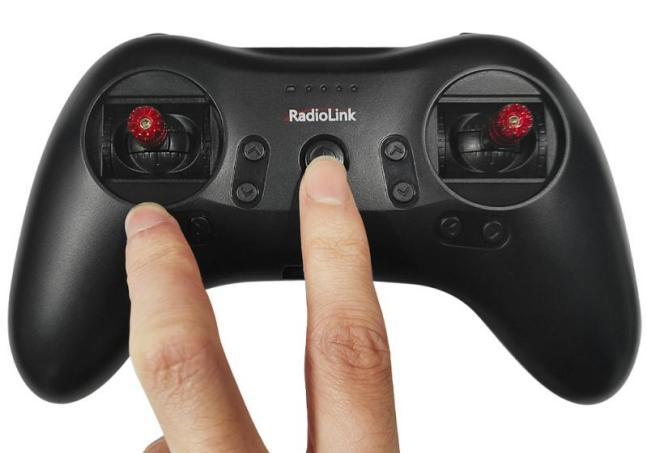
2. Range Calibration: Toggle both sticks (Ch1-4) to the highest point/maximum and the lowest point/minimum. Then back to the central point. (Refer to image below)
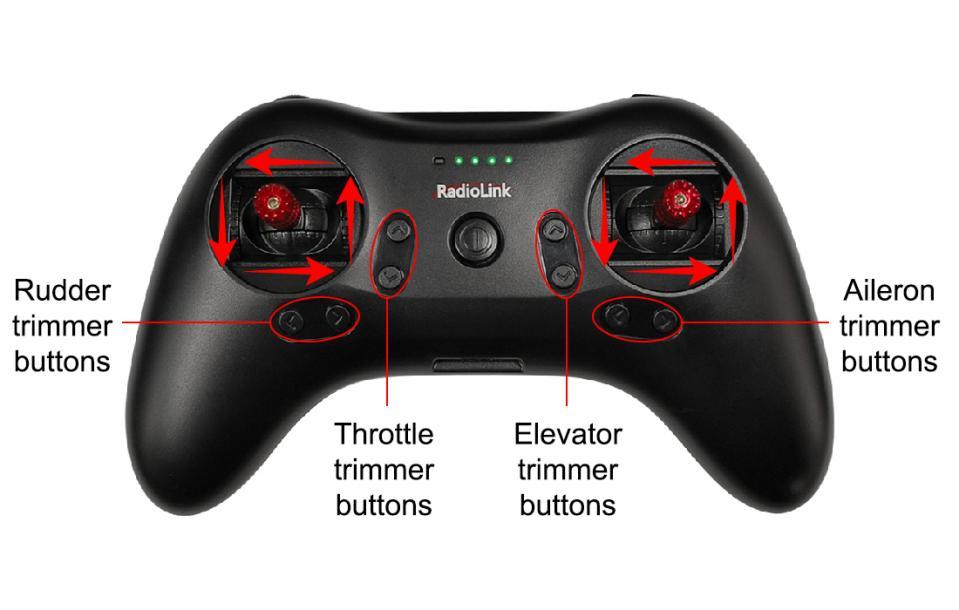
3. Central Point Calibration: When the joysticks are placed in the central point, press rudder trimmer button (The second button on the left), there will be DD sound. Four flashing LED indicators turn solid green means stick calibration is complete.
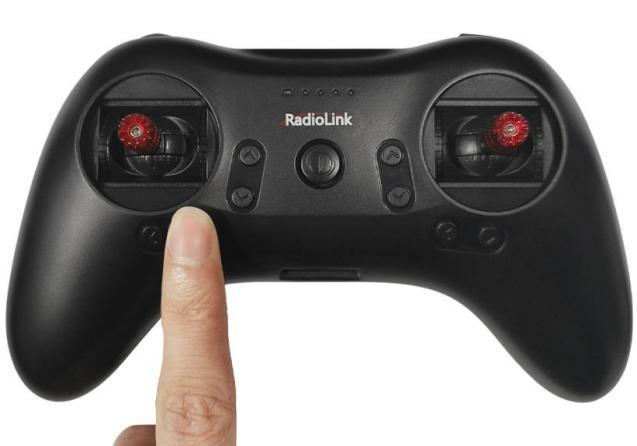
Chapter 3 Get Ready to Flight
Drone inspection:
1. Make sure the battery is installed securely and fully charged, and the battery is not bulging, deformed or damaged.
2. Inspect the propeller. Check whether the propeller is in good condition, without damage, cracks , aging and softening. Make sure the propellers are installed firmly and rotate smoothly, without jamming.
3. Inspect the fuselage and components. Scan the appearance of the fuselage to see if there is any damage, whether there are cracks in the screw connections, and whether the screws of each component are tight.
4. Check whether the motor installation is tight, and manually turn the motor to check whether the rotation is smooth.
5. Check the transmitter:
① Make sure the transmitter is fully charged.
②The joystick has no deformation in appearance and can be rotated flexibly without lag.
③The LED indicator of T8S lights up normally and there is no abnormal alarm signal.
Chapter 4 Three Flight Modes
CH5 three-position switch controls the three flight modes: alt-hold (low speed) mode, alt-hold (high speed) mode and stabilize mode. When the CH5 switch is moved to the bottom, it is in alt-hold (low speed) mode; When CH5 switch is in the center, it is alt-hold (high speed) mode; When CH5 switch is moved to the direction of CH6 push-button (the top), it is in stabilize mode. In alt-hold mode, when the throttle stick is at the midpoint, the aircraft can maintain a constant altitude and hover in the air. Above the midpoint of the throttle, the aircraft rises, and below the midpoint of the throttle, the aircraft descends.

Chapter 5 Flight Steps
5.1 Battery Installation
Prepare a 2S lipo battery that comes with VDS200.
Put the battery into the battery compartment.
Shake the drone to ensure that the battery is firm and does not fall off.
5.2 Power on VDS200
Long press the power button to power on T8S transmitter. Please make sure the throttle is at the lowest position, and CH7 switch is moved to the top, the disarm position.
Connect the battery to VDS200.
Make sure the LED of the receiver is always purple.
5.3 Take off
Place the drone on a flat ground and ensure that there are no interfering objects such as walls within 1 meter nearby.
Push CH7 switch to the bottom position to arm VDS200, and slowly raise the throttle joystick to the hover position. (It is recommended to fly in alt-hold (low speed) mode for your first flight)
Hold the joystick tightly and hover the drone in the air according to the flight attitude of the aircraft.
5.4 Landing
Hover the drone over the landing site and slowly lower the throttle joystick.
After the drone lands, push CH7 to the top, the disarm position.
Note: When the battery voltage is lower than the set voltage, the drone will automatically land slowly and the throttle stick cannot control the drone.
5.5 Power off VDS200
Unplug the battery of VDS200.
Power off T8S transmitter.
Store the drone and transmitter appropriately to avoid being squeezed, exposed to moisture, or placed in a high temperature environment.
Chapter 6 Troubleshooting
|
Problems |
Solutions |
|
The aircraft cannot take off even though the throttle stick is at the highest position. |
The battery voltage is low. Please charge the battery and try again. |
|
The aircraft rolls after taking off. |
The propellers may be installed in wrong direction. Please adjust them and try again. |
|
There is an abnormal sound after the aircraft is armed. |
Arm the drone and turn the propeller by hand to check whether there are any objects or parts interfering with the propeller. Remove the objects. |
|
The aircraft shakes after it is armed. |
Check whether the propeller is intact. If not, please replace the propeller. |
|
The aircraft sways after takeoff. |
Check whether the propellers are securely installed. Please use propellers that come with the drone. |
|
The aircraft sways after taking off. |
Check whether the fixing screws at the bottom of the motor are loose and tighten the screws. |
|
The aircraft sways after taking off. |
Check whether the motor fixing rubber ring is deformed. |
|
Some motors do not rotate after arming. |
Check whether the motor plug and the corresponding socket of the flight controller are connected properly. |
|
In the stationary state, the drone cannot stand on the ground. |
Check whether the shell is damaged and replace the shell components. |
|
After taking off, the aircraft deflects in one direction. |
Turn the trim button. When the trim returns to the center, it will emit a long beep to determine whether the trim position is correct. |
|
The drone loses control after taking off. |
Check if there is any strong signal interference source nearby. Please fly away from the interference source. |
|
The drone loses control in a short distance after taking off. |
Check whether the receiver antenna is broken or damaged. If damaged, replace the receiver. |
|
Unable to arm the drone. |
Calibrate the transmitter. For specific methods, please refer to Chapter 2.6 T8S Joystick Calibration. |
Thank you again for choosing RadioLink products.
If the above communication cannot solve your problem, you can also send emails to our technical support: after_service@radiolink.com.cn
Thank you again for choosing the RadioLink product.